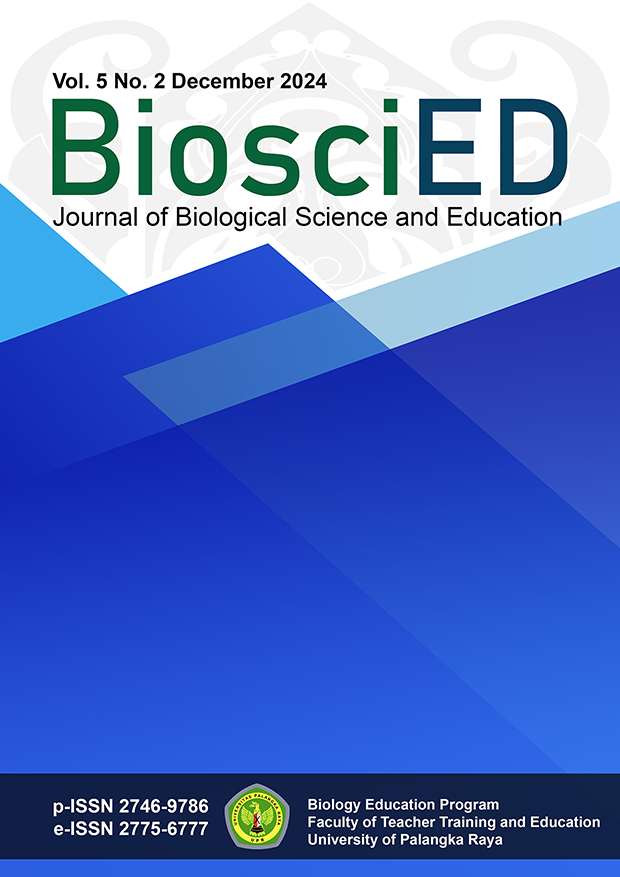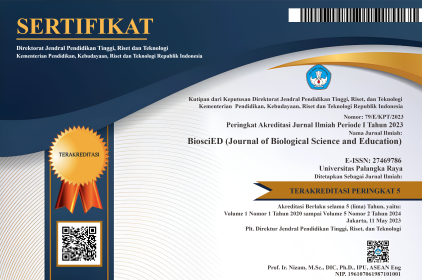Catatan Tamang Mangkinang (Elaeocarpus glaber Blume) di Kalimantan Tengah
Records of Tamang Mangkinang (Elaeocarpus glaber Blume) in Central Kalimantan
DOI:
https://doi.org/10.37304/bed.v5i2.18077Keywords:
Buah Lokal, Elaeocarpus, Konservasi, Tamang MangkinangAbstract
Abstrak. Elaeocarpus glaber Blume merupakan tumbuhan buah liar dapat dimakan yang memiliki ciri khas endokarp yang berukiran dan baraluran. Saat ini, spesies Elaeocarpus glaber Blume telah mengalami perubahan status konservasi dari terancam menjadi resiko rendah pada laman jejaring IUCN, namun informasi yang diperoleh dilapangan bahwa masyarakat Desa Bukit Rawi telah menebang banyak tanaman dewasa. Sehingga, penelitian ini tetap bertujuan untuk memperkuat penentuan status dengan mengumpulkan data tentang keberadaan Elaeocarpus glaber di Kalimantan Tengah menggunakan metode jelajah dan wawancara. Hasil menunjukkan tercatat delapan lokasi pernah dilaporkan serta satu lokasi adalah terbaru, dikoleksi di habitat tanah liat di tepi sungai Kahayan Tengah di Desa Bukit Rawi.
Abstract. Elaeocarpus glaber Blume is an edible wild fruit plant that characteristised by a sculptured to sulcate endocarp. Currently, the Elaeocarpus glaber Blume species has undergone a change in conservation status from Threatened to Least Concern on the IUCN website, even though the field information was obtained that the Bukit Rawi Village community has cut down many mature plants. Therefore, this study still purpose to strengthen the status determination by collecting data on the presence of Elaeocarpus glaber in Central Kalimantan using eksploration method and interviews. The results showed that eight locations were reported and one location was the most recent, which is collected in a clay habitat on the riverbanks of the Kahayan Tengah in Bukit Rawi Village
Downloads
References
Aqim S & Permatasari IT (2023). Keanekaragaman Species Hutan Lindung Gunung Slamet. Nomor 1July-December 2023 journal.bengkuluinstitute. Vol. 1 No. 1. Hal. 21-30.
A KeBler, P. J., Sidiyasa, K., & Zainal, A. (1995). Checklist of secondary forest trees in east an d south kalimant an, indonesia.
Alexiades, M. (1996). Collecting ethnobotanical data: An introduction to basic concepts and techniques. In Selected Guidelines for Ethnobotanical Research: A Field Manual (pp. 53–94).
Antonelli, A., Fry, C., Smith, R., Eden, J., Govaerts, R., PJ, K., Nic Lughadha, E., Onstein, R., Simmonds, M., Zizka, A., Ackerman, J., Adams, V., Ainsworth, A., Albouy, C., Allen, A., Allen, S., Allio, R., Auld, T., Bachman, S., & Zuntini, A. (2023). State of the World’s Plants and Fungi 2023. https://doi.org/10.34885/wnwn-6s63
Baba Y. (2013). Evolution, systematics and taxonomy of Elaeocarpus (Elaeocarpaceae) in Australasia. Thesis
Baba, Y., & Crayn, D. (2012). Elaeocarpus hylobroma (Elaeocarpaceae): A new species endemic to mountain tops in north-east Queensland, Australia. Kew Bulletin, 67(4), 743–750. https://doi.org/10.1007/s12225-012-9398-9
Baba, Y., Rossetto, M., & Crayn, D. M. (2020). Identifying evolutionary lineages in the Elaeocarpus obovatus complex: Population genetics and morphometric analyses support a new subspecies, Elaeocarpus obovatus subsp. umbratilis, from northern Queensland, Australia. Australian Systematic Botany, 33(4), 346–379. https://doi.org/10.1071/SB18054
Brambach, F., Coode, M., Biagioni, S., & Culmsee, H. (2016). Elaeocarpus firdausii (Elaeocarpaceae), a new species from tropical mountain forests of Sulawesi. PhytoKeys, 62(1), 1–14. https://doi.org/10.3897/phytokeys.62.7548
Christenhusz, M. J. M., & Byng, J. W. (2016). The number of known plants species in the world and its annual increase. In Phytotaxa (Vol. 261, Issue 3, pp. 201–217). Magnolia Press. https://doi.org/10.11646/phytotaxa.261.3.1
Coode MJE (1995) Elaeocarpus in the Flora Malesiana area: E. kraengensis and ten new species from Sulawesi. Kew Bulletin 50: 267–294. doi: 10.2307/4110631
Coode MJE (1996). Elaeocarpus for Flora Malesiana: notes, new taxa and combinations in sect. Elaeocarpus: 2. Kew Bulletin 51: 83–101. doi: 10.2307/4118746
Coode, M. (2004). Elaeocarpaceae (pp. 135–144). https://doi.org/10.1007/978-3-662-07257-8_18
Coode MJE (2007) Elaeocarpaceae for Flora Malesiana: new information on Elaeocarpus from Borneo and Sulawesi. Kew Bulletin 62: 329-331.
Coode, M. J. E. (2010). Elaeocarpus for Flora Malesiana: new taxa and understanding in the Ganitrus group. In Source: Kew Bulletin (Vol. 65, Issue 3).
Coode MJE and Weibel R. (1994). Elaeocarpus for Flora Malesiana: Notes, New Taxa and Combinations in sect. Elaeocarpus: 1. In Source: Kew Bulletin (Vol. 49, Issue 2).
Crayn, D. M., Rossetto, M., & Maynard, D. J. (2006). Molecular phylogeny and dating reveals an Oligomiocene radiation of dry-adapted shrubs (former Tremandraceae) from rainforest tree progenitors (Elaeocarpaceae) in Australia. American Journal of Botany, 93(9), 1328–1342. https://doi.org/10.3732/ajb.93.9.1328
Diaz, S., Settele, J., Brondízio, E., Ngo, H. T., Agard, J., Arneth, A., Balvanera, P., Brauman, K., Butchart, S., Chan, K., Garibaldi, L., Ichii, K., Liu, J., Subramanian, S., Midgley, G., Miloslavich, P., Molnár, Z., Obura, D., Pfaff, A., & Zayas, C. (2019). Pervasive human-driven decline of life on Earth points to the need for transformative change. Science (New York, N.Y.), 366. https://doi.org/10.1126/science.aax3100
Elaeocarpus glaber Blume in GBIF Secretariat (2023). GBIF Backbone Taxonomy. Checklist dataset https://doi.org/10.15468/39omei diakses melalui GBIF.org on 2024-12-16.
Fedde F. (1878). Just's Botanischer Jahresbericht. https://www.biodiversitylibrary.org. diakses Agustus 2024
Gledhill, D. (2008). The names of plants: Fourth edition. https://doi.org/10.1017/CBO9780511550898
Hardainiyan, S., Nandy, B., & Chaudhary, K. (2015). Elaeocarpus Ganitrus (Rudraksha): A Reservoir Plant with their Pharmacological Effects. International Journal of Pharmaceutical Sciences Review and Research, 34, 55–64.
IUCN 2024. The IUCN Red List of Threatened Species. Version 2024-2. https://www.iucnredlist.org. diakses September 2024
IPNI (2024). International Plant Names Index. Published on the Internet http://www.ipni.org, The Royal Botanic Gardens, Kew, Harvard University Herbaria & Libraries and Australian National Herbarium. diaksesSeptember 2024.
Irawan, A. P., Siregar, J. P., Cionita, T., Fitriyana, D. F., Alias, A., Rusiyanto, R., Jaafar, J., Prayitno, P., Ismail, R., Bayuseno, A. P., & Janvekar, A. A. (2024). Elaeocarpus ganitrus (rudraksha) seeds as a potential sustainable reinforcement for polymer matrix composites. Polymer Composites, 45(5), 4662–4679. https://doi.org/https://doi.org/10.1002/pc.28088
JSTOR (2024) Global Plants on JSTOR. http://plants.jstor.org/ diakses September, 2015
Karuppa Samy, K., & Ramasubbu, R. (2022). Floral traits and phenology drive pollinators diversity and pollinators visits in selected endemic Elaeocarpus spp. of the Western Ghats. Acta Ecologica Sinica, 42(4), 296–311. https://doi.org/https://doi.org/10.1016/j.chnaes.2021.12.003
Koorders, S. H., & Valeton, T. (1915). Atlas der baumarten von Java : im anschluss an die “Bijdragen tot de kennis der boomsoorten van Java” / zusammengestellt von dr. S.H. Koorders und dr. Th. Valeton ; mit unterstützung der Niederländsch- indischen regierung ; Herausgegeben von dr. S.H. Koorders: Vol. v.3 (1915). Buch- und Steindruckerei. https://www.biodiversitylibrary.org/page/47163165
Mahomoodally, M. F., & Sookhy, V. (2018). Ethnobotany and Pharmacological Uses of Elaeocarpus floribundus Blume (Elaeocarpaceae). In Plant and Human Health, Volume 1 (pp. 125–137). Springer International Publishing. https://doi.org/10.1007/978-3-319-93997-1_4
Mariaty, A. I., Purwanto Budi Santosa, dan, Studi Kehutanan Universitas Muhammadiyah Palangkaraya, P., Penelitian dan pengembangan Lingkungan Hidup, B., & Banjarbaru, K. (2019). Study of biodiversity level on burnt land at Sebangau National Park & forest area with specific purposes (KHDTK) Tumbang Nusa. In Jurnal Daun (Vol. 6, Issue 2).
Matthews, M. L., & Endress, P. K. (2002). Comparative floral structure and systematics in Oxalidales (Oxalidaceae, Connaraceae, Brunelliaceae, Cephalotaceae, Cunoniaceae, Elaeocarpaceae, Tremandraceae). Botanical Journal of the Linnean Society, 140(4), 321–381. https://doi.org/10.1046/j.1095-8339.2002.00105.x
Merrill, E. D. (Elmer D. (1917). Alabastra Borneensia. Journal of the Straits Branch of the Royal Asiatic Society, 77, 189–247. https://www.biodiversitylibrary.org/part/375634
Merrill, E. D. (Elmer D. (1921). A bibliographic enumeration of Bornean plants. A Bibliographic Enumeration of Bornean Plants, Special Number, 1–637. https://www.biodiversitylibrary.org/part/308205
Nic Lughadha, E., Bachman, S., Leão, T., Forest, F., Halley, J., Moat, J., Acedo, C., Bacon, K., Brewer, R., Gâteblé, G., Gonçalves, S., Govaerts, R., Hollingsworth, P., Krisai-Greilhuber, I., De Lirio, E., Moore, P., Negrão, R., Onana, J., Rajaovelona, L., & Walker, B. (2020). Extinction risk and threats to plants and fungi. Plants People Planet, 2, 389–408. https://doi.org/10.1002/ppp3.10146
Rifai, M. A. ., & Puryadi, Dedi. (2008). Glosarium biologi. Pusat Bahasa, Departemen Pendidikan Nasional.
Rugayah, R. A., Windadri, F. I., & Hidayat, A. (2004). Pengumpulan data taksonomi. Di Dalam: Rugayah, Widjaja EA, Praptiwi, Editor. Pedoman Pengumpulan Data Keanekaragaman Flora. Bogor: Puslit Biologi LIPI.
Sharma, S., Hussain, S., Rai, D. V., & Singh, A. N. (2023). A comprehensive analysis on the ecosystem services of Elaeocarpus L. (Elaeocarpaceae): a review. In Journal of Phytology (Vol. 15, pp. 12–37). TathQeef Scientific Publishing. https://doi.org/10.25081/jp.2023.v15.8020
Sidha Bhagawanl, W., Widya Ramdhani, A., Suproborini, A., & Novi Primiani, C. (2024). Uji Aktivitas Antioksidan dan Skrining Fitokimia Ekstrak N-Heksana Buah Genitri (Elaeocarpus ganitrus Roxb. ex G.Don ) dengan Metode DPPH Antioxidant Activity Test and Phytochemical Screening of N-heksana Extract of Genitri Fruit (Elaeocarpus ganitrus Roxb. ex G.Don ) using the DPPH Method. Journal of Islamic Medicine, 8(1), 2024. https://doi.org/10.18860/jim.v8i1.26469
Soedjito, H. (1984). Dinamika Hutan Di Long Sei Barang, Apo Kayan Kalimantan Timur. Berita Biologi, 2(8), 68936.
Tang, Y., & Phengklai, ; Chamlong. (2007). Elaeocarpaceae. Flora of China, 12, 223.
Utteridge, T., & Bramley, G. (2014). The Kew Tropical Plant Families Identification Handbook.
Widodo, R., Rusiyanto, R., Kriswanto, K., Naryanto, R., Boy, A., Fitriyana, D., Siregar, J., Cionita, T., Mamat, R., Jaafar, J., & Ammarullah, M. I. (2024). Investigation of Elaeocarpus ganitrus seed (EGs) powder as a sustainable composite biomaterial: Effects of particle size on the mechanical, frictional, and thermal properties for potential biomedical applications. AIP Advances, 14. https://doi.org/10.1063/5.0228259
Zmarzty, S. (2001). Revision of Elaeocarpus (Elaeocarpaceae) Section Elaeocarpus in Southern India and Sri Lanka. Kew Bulletin, 56(2), 405–447. https://doi.org/10.2307/4110964
Downloads
Published
How to Cite
Issue
Section
License
Copyright (c) 2024 Ria Windi Lestari, Muhammad Rizki, Fadhila Aziz, Awalul Fatiqin, Muhammad Irmawan

This work is licensed under a Creative Commons Attribution 4.0 International License.















